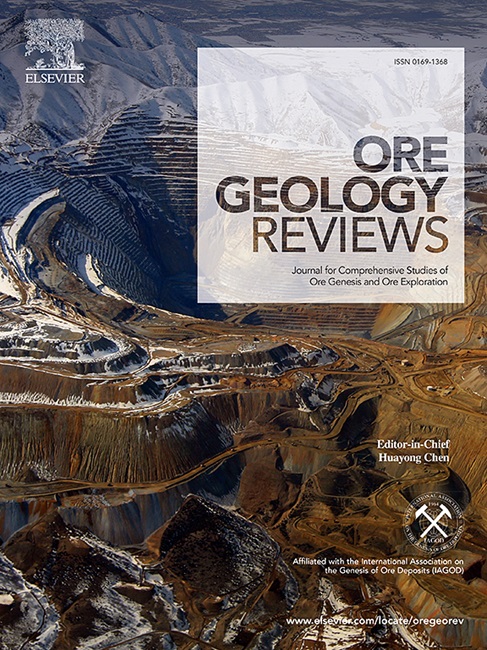Melt fluid evolution and ore-forming mechanism of the Murong superlarge single-vein pegmatite-type lithium deposit in western Sichuan, China
IF 3.2
2区 地球科学
Q1 GEOLOGY
引用次数: 0
Abstract
The Murong superlarge pegmatite-type lithium deposit is located in the Songpan–Ganze orogenic belt in western Sichuan, China, and is now the largest single-vein pegmatite-type lithium deposit in Asia. This paper analyzes the melt fluid evolution process, lithium enrichment, and mineralization mechanism of lithium-rich pegmatite by studying the types of inclusion assemblages, estimated capture temperatures and pressures, and inclusion compositions of spodumene and associated minerals in different zones of the pegmatite. The Murong pegmatite can be laterally divided into three zones: the felsic shell zone (Zone Ⅰ), the coarse-grained spodumene zone (Zone Ⅱ), and the felsic core zone (Zone Ⅲ). Spodumene mainly develops in Zone Ⅱ. This study reveals six types of inclusions in the Murong pegmatite: melt inclusions (T1-1), melt–fluid inclusions (T1-2), crystal–rich inclusions (T1-3), CO2–NaCl–H2O system inclusions (T2), NaCl–H2O system inclusions (T3), and monophase CO2 inclusions (T4). There are significant differences in the melt/fluid inclusion assemblages and the formation temperatures of inclusions in different zones. The overall trend is from melt inclusions + melt–fluid inclusions to crystal–rich inclusions to CO2–NaCl–H2O system inclusions and then to NaCl–H2O system inclusions, which records the complete process of pegmatite magma evolution from melt fluids to hydrothermal fluids, indicating a high degree of evolution of the pegmatite magma. During evolution from melt fluids to hydrothermal fluids, the composition system evolves from a high temperature (>450 °C) lithium-rich phosphate-lithium-rich carbonate silicate system enriched with volatile components (F2, CO2, B) to a medium to high temperature (240–350 °C) lithium-rich phosphate–lithium-containing carbonate silicate system enriched with volatile components (CO2, B) and then to a medium to low temperature (<300 °C) hydrothermal fluid system enriched with volatile components (CO2). The ore-forming process mainly occurred during decompression and cooling as melt fluids evolved into hydrothermal fluids, with pressures ranging from approximately 5 kbar to 1.5 kbar during mineralization. The ore-forming fluids evolved from a weakly alkaline environment in the early stage to an acidic environment in the late stage. Immiscibility is an important mechanism for promoting the precipitation of spodumene during the evolution of Murong pegmatite magma fluid. Compared with other pegmatite-type lithium deposits in the same tectonic belt, the extremely thin Zone Ⅰ (magmatic crystallization zone) and the absence of planar zoning in the study area suggest that the original magma, from which the pegmatite-type lithium deposits in the study area formed, may have been highly differentiated. The full-vein mineralization of the pegmatite may be related to the extremely high degree of differentiation of the original magma. Volatile components (F, B, P, and CO2, etc.) playing an important role in the enrichment and migration of rare alkali metals.

川西慕容特大单脉伟晶岩型锂矿床熔体流体演化及成矿机制
慕容超大型伟晶岩型锂矿床位于中国川西松潘—甘孜造山带,是目前亚洲最大的单脉伟晶岩型锂矿床。本文通过研究富锂伟晶岩不同带的包裹体组合类型、估算捕获温度和压力、锂辉石及伴生矿物包裹体组成,分析了富锂伟晶岩的熔融流体演化过程、锂富集及成矿机制。慕容伟晶岩横向上可分为长英质壳带(Ⅰ)、粗粒锂辉石带(Ⅱ)和长英质核带(Ⅲ)3个带,其中锂辉石主要发育在Ⅱ带。研究发现,在芦容伟晶岩中存在熔融包裹体(T1-1)、熔融流体包裹体(T1-2)、富晶包裹体(T1-3)、CO2 - NaCl-H2O体系包裹体(T2)、NaCl-H2O体系包裹体(T3)和单相CO2包裹体(T4) 6种类型的包裹体。不同带的熔体/流体包裹体组合和包裹体的形成温度存在显著差异。总体趋势为熔融包裹体+熔融流体包裹体→富晶包裹体→CO2-NaCl-H2O体系包裹体→NaCl-H2O体系包裹体,记录了伟晶岩岩浆从熔融流体到热液流体演化的完整过程,表明伟晶岩岩浆演化程度较高。在熔融流体向热液流体演化过程中,组成体系由高温(>450℃)富锂磷酸盐-富锂碳酸盐硅酸盐体系(富含挥发性组分F2、CO2、B)演化为中高温(240 ~ 350℃)富锂磷酸盐-含锂碳酸盐硅酸盐体系(富含挥发性组分CO2、B),然后进入中低温(<300℃)富含挥发性组分(CO2)的热液系统。成矿过程主要发生在减压冷却过程中,熔融流体演化为热液流体,成矿过程压力约为5 ~ 1.5 kbar。成矿流体由早期的弱碱性环境演变为晚期的酸性环境。在慕容伟晶岩岩浆流体演化过程中,非混相作用是促进锂辉石沉淀的重要机制。与同一构造带其他伟晶岩型锂矿床相比,研究区极薄的岩浆结晶带Ⅰ(岩浆结晶带)和无平面分带,表明研究区伟晶岩型锂矿床形成的原岩浆可能已高度分化。伟晶岩的全脉化可能与原岩浆分异程度极高有关。挥发性组分(F、B、P、CO2等)对稀有碱金属的富集和迁移起着重要作用。
本文章由计算机程序翻译,如有差异,请以英文原文为准。
求助全文
约1分钟内获得全文
求助全文
来源期刊

Ore Geology Reviews
地学-地质学
CiteScore
6.50
自引率
27.30%
发文量
546
审稿时长
22.9 weeks
期刊介绍:
Ore Geology Reviews aims to familiarize all earth scientists with recent advances in a number of interconnected disciplines related to the study of, and search for, ore deposits. The reviews range from brief to longer contributions, but the journal preferentially publishes manuscripts that fill the niche between the commonly shorter journal articles and the comprehensive book coverages, and thus has a special appeal to many authors and readers.
 求助内容:
求助内容: 应助结果提醒方式:
应助结果提醒方式:


